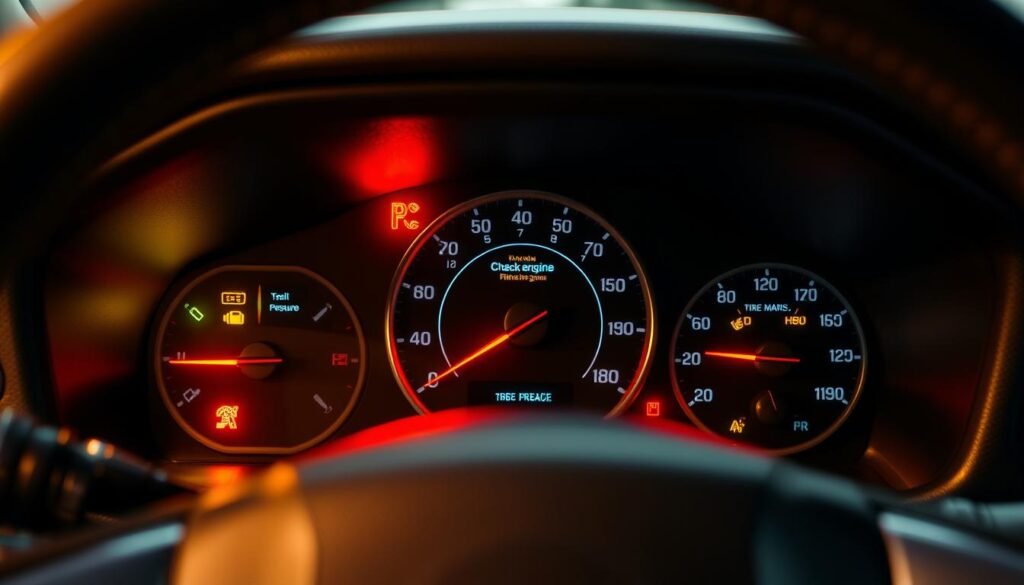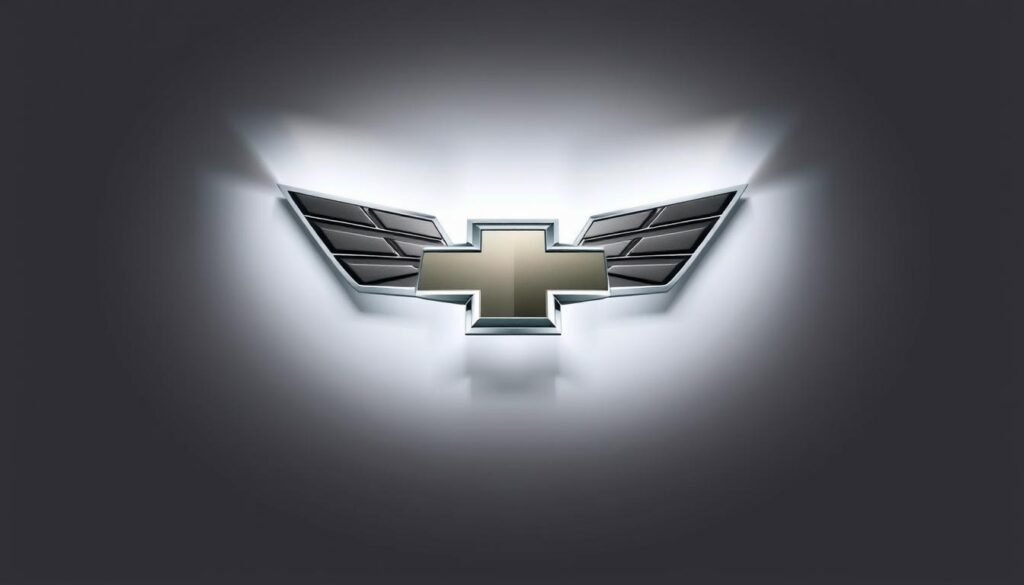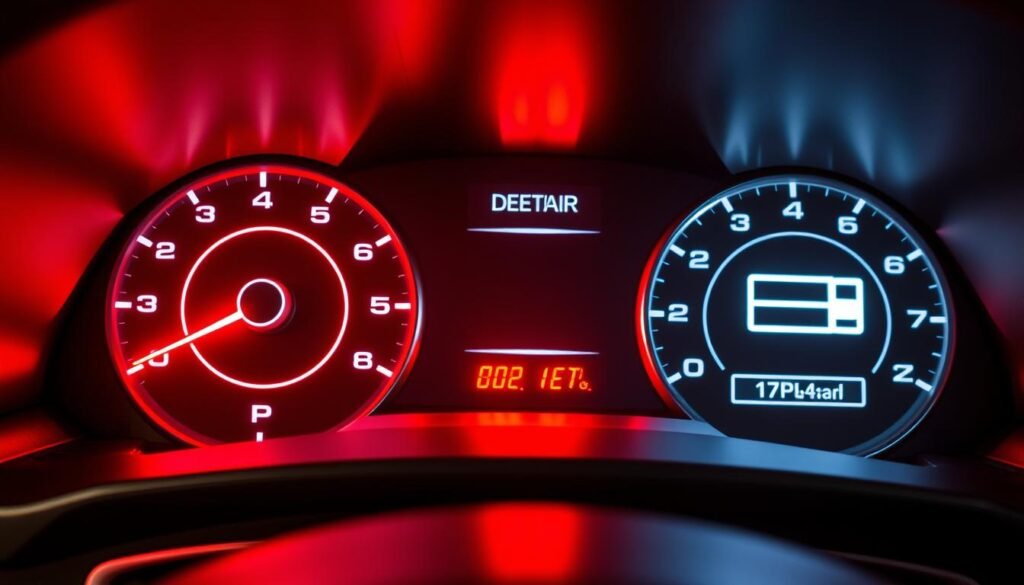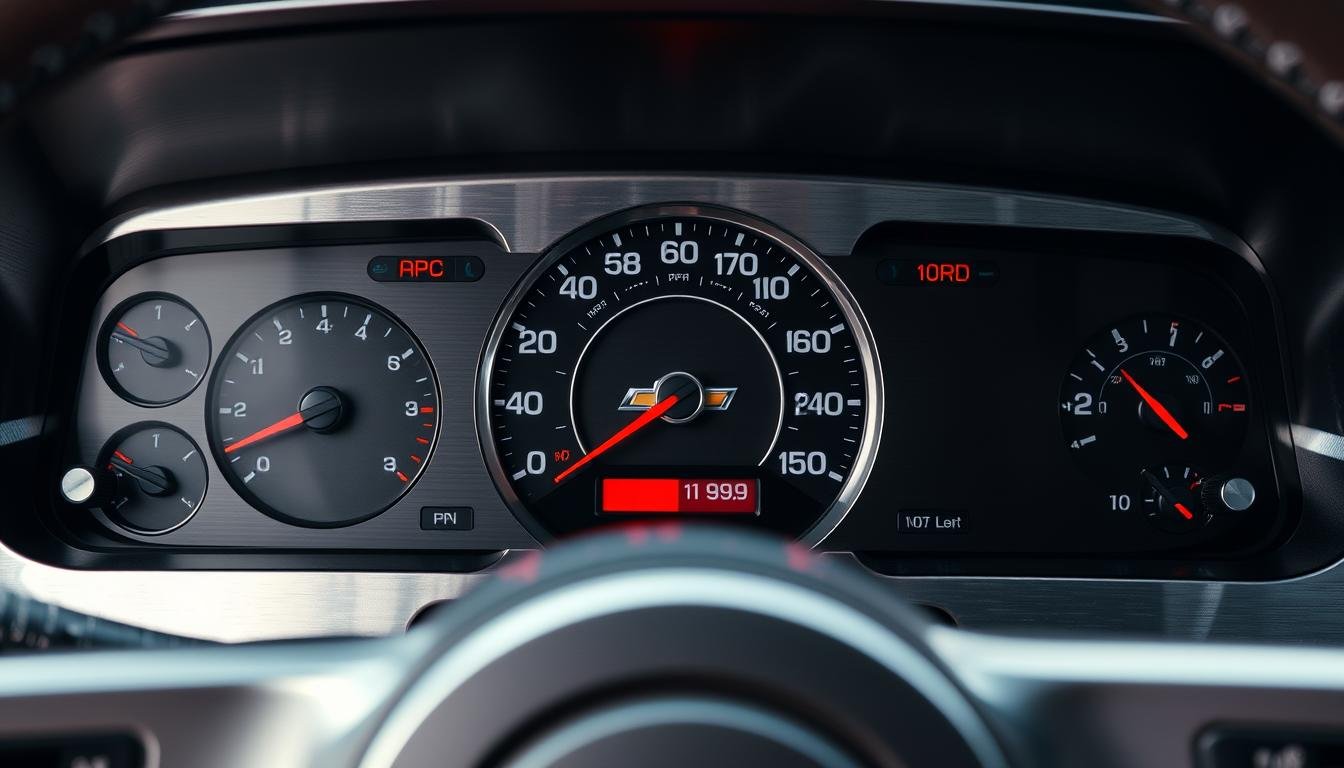Chevy Dashboard Symbols And Meanings? Exclusive Guide
Every Chevy owner should know the dashboard symbols and meanings. These symbols, whether warnings or info icons, help you act quickly to keep your car running well.
This guide will make it easier to recognize and understand Chevy’s common dashboard symbols.
The check engine light, or malfunction indicator lamp, might show for small or big issues. Critical warnings like the ABS light or tire pressure symbol are important too.
They tell you about problems that could hurt your safety and the car’s performance. Knowing these symbols can prevent car troubles and make your drives better.
Learning about alerts for engine oil pressure or the battery can help you get service sooner. This can stop bigger problems later on.
Next, we’ll go into more detail about Chevy dashboard symbols and meanings. This will help you know more about your car’s needs and make you a safer driver.
Introduction To Chevy Dashboard Symbols
Chevy dashboard symbols are key signals about your car’s condition and performance. They help you keep your vehicle running well and safely.
The dashboard is your guide, alerting you to different system statuses and issues. Knowing what these symbols mean is crucial.
It helps you react correctly to warnings for a better drive. When you see a symbol light up, it’s telling you something needs attention.
Symbols range from warning lights to information indicators. For instance, the Check Engine Light could mean a small problem or something more serious, depending on its state.
This guide will explain these symbols in detail. Learning them lets you address issues before they get worse.
Importance of Learning Dashboard Symbols
Knowing what dashboard symbols mean is crucial for keeping your car running smoothly and safely. These symbols can warn you early of problems, avoiding bigger issues later.
For example, the low fuel warning lights up when you’ve got less than 15% gas left. This heads-up can save you from getting stranded.
Smaller Chevy cars might go another 30 miles, but bigger ones can go about 50 miles after this warning.
If you ignore warnings like the check engine light, you’re risking serious car trouble. This light turns on for about 10% of cars, showing it’s a common and important alert.
Overlooking it can cause damage that costs over $1,200 to fix. By paying attention to Chevy’s warning lights, you can stay safer on the road and even cut repair costs by up to 30%.
These dashboard symbols also use colors to show the level of urgency. Green means all’s good, yellow suggests a possible issue, and red warns of a serious problem.
Shockingly, 80% of drivers don’t know these color codes. Getting your car serviced when dashboard alerts pop up can make it run better and last longer by up to 20%.
eing alert to your dashboard symbols is a skill worth developing.
Overview of Common Chevy Dashboard Indicator Lights
Knowing your vehicle’s dashboard lights is key to driving safely and keeping your car in good shape.
Common Chevy dashboard lights give important info about how your car is doing. Learning about these lights means you can spot issues early and handle them quickly.
Warning Lights vs. Indicator Lights
Dashboard lights are split into warning lights and indicator lights. Warning lights mean you need to act fast.
For example, the oil level light signals it’s time for more oil, while a hot engine light warns of overheating. Ignoring these can cause big problems and expensive fixes.
On the flip side, indicator lights just give you updates and usually aren’t urgent. The fuel gauge light shows how much gas you have, and the cruise control light shows if it’s on.
Types of Lights on Different Chevy Models
Chevy cars have different dashboard lights for their needs, though many are the same across models.
Here’s a list of common Chevy dashboard lights and what they mean:
| Light | Description |
|---|---|
| Oil Level Warning Light | Indicates a need for lubrication, suggesting a service visit is necessary. |
| Low Fuel Indicator Light | Activates when the fuel gauge is nearly empty, warning drivers to refuel before running out. |
| High Engine Temperature Light | Signifies that the engine has overheated, requiring immediate action to prevent damage. |
| Engine Malfunction Light | Indicates a serious engine issue that must be addressed promptly. |
| Tire Pressure Warning Light | Signals that one or more tires are underinflated, necessitating a pressure check. |
| Charging System Light | May indicate that the alternator is not charging the battery properly. |
| Airbag Readiness Light | If it stays on or flashes, it may indicate an airbag system malfunction. |
Knowing about these dashboard lights can help you stay aware and keep your Chevy running smoothly on the road.

Chevy Dashboard Symbols and Meanings
It’s essential to understand what your Chevy’s dashboard symbols mean. This knowledge helps keep your vehicle in top condition.
We’ll cover the meanings behind key warning lights and indicators. Having a Chevy symbol guide makes it easier to know when to act.
Knowing Specific Warning Lights
There are many warning lights on your Chevy’s dashboard. Each one has a special purpose. Let’s look at some common symbols you might see:
| Symbol | Meaning | Recommended Action |
|---|---|---|
| Check Engine Light | Indicates a malfunction in the engine or propulsion system. | Seek immediate service to avoid severe engine damage. |
| Engine Coolant Temperature Warning Light | Indicates that the vehicle has overheated. | Turn off the engine to prevent damage. |
| Engine Oil Pressure Light | Warns of low oil pressure. | Avoid restarting the vehicle if light stays on for more than 10 seconds. |
| Low Fuel Warning Light | Signals that fuel is low. | Refuel promptly; further service required if light remains on after refueling. |
| Charging System Light | Indicates potential issues with the electrical system. | Stop driving to prevent draining the battery. |
| Low State of Charge Light | Alerts of low charge in electric vehicles. | Charge the vehicle immediately. |
| Battery Fault Light | Indicates a high voltage battery system issue. | Seek immediate service. |
| Brake System Warning Light | Signifies low brake fluid or a brake system problem. | Immediate service is essential. |
| Tire Pressure Light | Indicates underinflated tires. | Check and inflate tires to the correct PSI. |
Commonly Asked Questions About Chevy Symbols
- What should I do if the Check Engine Light comes on? Follow the chevy symbol guide to assess the issue and seek professional help.
- How can I ensure that my dashboard symbols are functioning properly? Regular maintenance checks will help you decipher chevy dashboard symbols accurately.
- Why does the Brake System Warning Light stay on? This implies a potential issue with the braking system that requires immediate attention.
- What is the importance of knowing these symbols? Familiarity with these alerts allows you to respond promptly, reducing repair costs and maintaining safety.

Seat Belt and Airbag Warning Lights
The seat belt warning light reminds you to buckle up. It’s key for safe travel. When this light turns on, it means someone isn’t buckled in. So, you need to check all belts right away.

The airbag readiness light is just as crucial. It warns you if there’s an airbag problem. This issue could stop airbags from working during a crash.
It involves important parts like crash sensors and needs quick attention. Automakers say to get your car checked if this light turns on.
Ignoring it is risky because the airbag system is complex. Messages like “airbag system malfunction” tell you it needs expert care.
Driving with this light on endangers your safety. If it stays on, towing your car might be safer. The causes can vary from simple to serious, like sensor issues.
Both lights are vital for your safety. Reacting quickly when they light up is essential. It helps keep everyone safe while driving.
Engine and Battery Warning Lights
The engine warning light and battery status light are key alerts on your Chevy. They tell you about potential problems.
If you don’t pay attention to them, you might face big repairs later. It’s important to know what they mean and when to get help to keep your car running well.
When To Seek Service
The engine warning light could mean many things. It might be a small issue, like a loose gas cap. Or it could show a big problem with the engine.
If you see this light, get your car checked quickly. Not doing so might cause serious engine damage.
The battery light means there’s a problem with the charging system. It could be a dead battery or a bad alternator.
If this light stays on after you start the car, or if it flashes, get help right away. This will help you avoid getting stuck somewhere.
Other important lights to watch are:
- Engine Coolant Temperature Warning Light: Means the engine is too hot; driving could harm the engine.
- Engine Oil Pressure Light: Shows low oil pressure; check the oil to avoid damage.
- Charging System Light: Warns of electrical system issues, which could drain the battery.
- Battery Fault Light: Shows a problem with the high-voltage battery, needs quick service.
Don’t ignore these warning lights. Paying attention to them can make your car last longer and run better.
| Warning Light | Description | Action Required |
|---|---|---|
| Engine Warning Light | Shows possible engine or system issues. | Get a diagnostic test right away. |
| Battery Status Indicator | Tells of charging system problems. | Check the battery and alternator; get service if needed. |
| Engine Coolant Temperature Warning Light | Engine’s overheating. | Stop driving and turn off the engine. |
| Engine Oil Pressure Light | Indicates oil pressure is low. | Check oil; get help if the light remains on. |

Braking, Accelerating, and Steering Warning Lights
It’s vital to know your car’s braking and steering warning lights for safe driving. These indicators flag up potential mechanical problems affecting how your car performs.
For example, an illuminated ABS light points to issues with the wheel speed sensors or control module. Ignoring it could reduce your ability to brake quickly in emergencies.
Braking indicator lights have several roles, including highlighting issues within your brake system.
If this light stays on after you start the car, it could mean your brake fluid is low or your brake pads are worn.
Checking your brake system regularly helps prevent accidents and boosts your vehicle’s safety.
The traction control light links to the steering warning and shows your car is trying to keep grip under slippery conditions.
A flashing light means the system is on the job. But if the light stays on, there might be a fault that needs checking.
Here’s a comparison of different braking and steering warning lights and what they signify:
| Warning Light | Meaning | Action Required |
|---|---|---|
| ABS Light | Indicates an issue with the Antilock Brake System | Seek professional assistance |
| Brake System Light | Signals low brake fluid or worn pads | Check brake fluid levels and inspect pads |
| Traction Control Light | System actively maintaining traction | No action needed if flashing; seek help if steady |
| Steering Warning Light | Indicates a problem with power steering | Have system checked as steering may become difficult |
Always keep an eye on your car’s braking and steering warning lights. Overlooking these warnings can dangerously affect your safety on the road.
Get your vehicle checked by a professional if any of these lights turn on to ensure safety is always your main focus while driving.
Vehicle Feature Warning Lights
Modern Chevy cars have smart features and sensors. These are key for safety on the road. They spot problems early, warning the driver.
Knowing what the icons like lane assist and adaptive cruise control mean helps you use these features. This makes driving safer.
Know Your Sensors and Technology
It’s important to understand the symbols on your dashboard. They are divided into colors:
- Green: Shows a system is on or working.
- Yellow: Tells you something might need checking soon.
- Red: Warns of a serious problem that needs quick action.
Here are some Chevy dashboard symbols you should know:
- Low Coolant Temperature
- High Coolant Temperature
- Braking System Failure
- Low Fuel
- Check Engine Light
- Anti-Lock Brake System (ABS)
- Blind Spot Warning
These icons alert you to different problems, from engine issues to safety warnings. Responding to these alerts on time can stop bigger problems.
It also helps your car last longer. If you need more info on an alert, check the car’s owner’s manual. For complex issues, get help from pros.
Colonial Chevrolet’s certified techs can diagnose problems. They fix cars using only real Chevrolet parts.
Charging and Battery Status Indicators
Knowing how your Chevy’s charging and battery indicators work is key for good vehicle health. This goes for both regular and electric models.
The charging system light helps you catch electrical system problems early. If you see it while driving, your alternator might not be charging the 12-volt battery right.
Don’t ignore this light; it might lead to your battery dying and your car breaking down. For electric cars, the low charge light means it’s time to plug in.
The charge cord light means you’re connected and charging. A battery fault light warns of serious battery issues needing quick fixes.
Lights like the propulsion power limited one signal trouble that could slow you down. Fixing issues shown by these lights is important for keeping your car reliable.
Here’s a table with details on what different lights mean and what to do about them:
| Indicator Light | Meaning | Action Required |
|---|---|---|
| Charging System Light | Potential problem with the electrical system or alternator | Check and service as needed |
| Low State of Charge Light | Electric vehicle is low on charge | Recharge immediately |
| Charge Cord Connected Light | Success confirmation of charge cord connection | No action needed |
| Battery Fault Light | Issue detected with the high voltage battery system | Immediate service required |
| Propulsion Power Limited Light | Fault detected in propulsion system | Monitor performance; seek service if needed |
Safety and Driver Assistance Feature Icons
Knowing what the icons in your Chevrolet mean can make you safer on the road. These icons tell you how the car’s safety features are working and help you react right.
For example, the Forward Collision Alert light comes on if there’s a car ahead, telling you to be careful.
And if you start to leave your lane without meaning to, the Lane Departure Warning icon lights up.
Being familiar with these Chevy safety features helps you spot problems early. Learning what each icon means allows you to act quickly and correctly.
Here are a few key icons you might see:
| Icon | Color | Meaning |
|---|---|---|
| Lane Keep Assist (LKA) | White/Green/Orange | Inactive/Active/Lane departure detected |
| Forward Collision Alert | Green/Orange | Vehicle detected/Tailgating |
| Driver Attention Assist | Yellow/Red | Drowsiness alert levels |
| Automatic Vehicle Hold (AVH) | Green | System actively holding vehicle |
| Brake System Warning | Red | Braking issue detected |
Regular checks, like oil changes and brake inspections, keep warning lights at bay. Keeping your Chevy’s safety features in check means driving with more peace of mind.
Stay up to date on what the icons mean. This way, you’ll know how to react when they light up.
Conclusion
Knowing what Chevy dashboard symbols mean is essential for your car’s safety and efficiency. Learning these signs helps you deal with alerts quickly.
From oil level notifications to serious warnings like the Check Engine Light, understanding each symbol is key.
This guide showed you the dashboard lights found in Chevy cars. It explained what they mean and how urgent they are.
By keeping informed, you can enhance your driving and avoid car problems. Watching these symbols carefully helps keep your car running well for a long time.
Learning about Chevy dashboard symbols makes you a smarter car owner. You’ll be ready for any car issues, keeping your Chevy safe and dependable. Knowing these symbols means taking care of your car’s health.
FAQs
What do the various Chevy dashboard symbols indicate?
Chevy dashboard symbols help you understand your car better. They alert you to how systems are doing, potential problems, or actions to take.
How can I differentiate between warning lights and indicator lights?
Warning lights mean you need to act fast to fix your vehicle. Indicator lights just give you updates without needing immediate action.
What should I do if the Check Engine light turns on?
When the Check Engine light comes on, get your car checked quickly to avoid bigger problems. Watch how your car is running for any unusual signs.
Why is it important to pay attention to seat belt and airbag warning lights?
These lights tell you if safety features might not work right. Ignoring them can put you at risk if there’s an accident.
What actions should I take when the battery warning light appears?
If you see the battery warning light, first check the battery connections for corrosion. If it keeps showing, get professional help to avoid more serious issues.
How can I enhance my understanding of Chevy feature warning lights?
Learning what each warning light for features, like lane assist, means can help you use these technologies better.
When is it critical to seek service for braking and safety-related warning lights?
If braking or safety lights come on, get service right away. These warnings can affect how well your vehicle drives and keeps you safe.
Are there differences in dashboard symbols across various Chevy models?
Yes, dashboard symbols can vary between Chevy models. Always check your owner’s manual for the most accurate info for your car.







